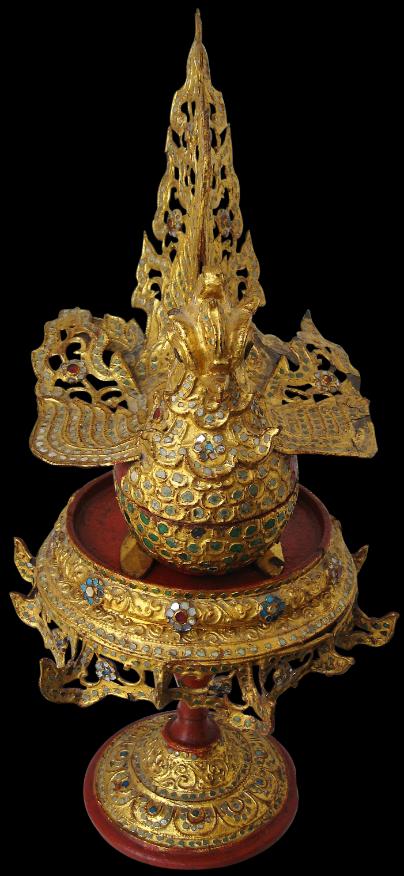
Burmese Lacquer Hintha Betel Container
Gold Lacquer Betel Box & Stand in the form of the Sacred Goose (Hintha)
Mandalay, Burma
19th century
height: 52cm
This extraordinarily ornate betel box and stand was used in Burma at ceremonies when young men entered a monastery as a novice to evoke the princely luxuries that Prince Siddhartha chose to give up when he embarked on a spiritual career which lead him to become the Buddha.
The betel box, comprising a base and a cover, is in the shape of a hintha or sacred goose with prominent wings and an unusually high tail. (In India, the hintha is known as the hamsa. In Burma as in India, the sacred goose was associated with royalty.)
The hintha sits on folded legs on a pedestal base. The hintha betel box and base are made from lacquered and gilded wood and ferrous metal with the lacquer being inlaid with foil-backed glass roundels. The non-gilded sections are decorated with cinnabar red lacquer. Both the stand and the hintha are further embellished with moulded relief work in lacquer putty, a technique known as thayo.
The plump body of the hintha separates into two halves revealing a shallow cavity decorated in plain red lacquer. This is where small quantities of betel were stored.
A pair of hintha boxes on stands such as this example form part of the decoration on an enormous Burmese Buddhist shrine (hpaya khan) currently on display in London’s Victoria & Albert Museum. A similar box is illustrated in McGill (2009, p. 89).
The condition of this box and stand is relatively good. There are some almost unavoidable losses to the lacquerwork but these are relatively minor. Overall, this is a fine example of an extraordinary piece of Burmese religious art.
References
Isaacs, R., & T.R. Blurton, Burma and the Art of Lacquer, River Books, 2000.
McGill, F. (ed.), Emerald Cities: Arts of Siam and Burma, 1775-1950, Asian Art Museum, 2009.
Provenance
UK art market.
Inventory no.: 1007
SOLD







A similar set displayed in the British Museum.


